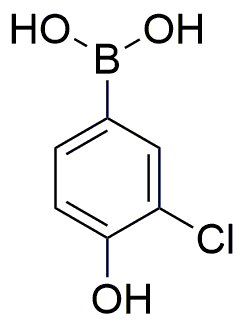3-Chloro-4-hydroxyphenylboronic acid is widely utilized in research focused on:
- Pharmaceutical Development: This compound plays a crucial role in synthesizing various pharmaceuticals, particularly in developing drugs that target specific biological pathways.
- Bioconjugation: It is used in bioconjugation processes to attach biomolecules to surfaces or other molecules, enhancing the efficacy of drug delivery systems.
- Organic Synthesis: The compound serves as a versatile building block in organic synthesis, allowing chemists to create complex molecules with precision.
- Diagnostics: It is employed in the development of diagnostic tools, particularly in assays that require specific binding interactions, improving the accuracy of disease detection.
- Material Science: The compound is used in creating advanced materials, including polymers and coatings, that exhibit enhanced properties such as durability and chemical resistance.
General Information
Properties
Safety and Regulations
Applications
3-Chloro-4-hydroxyphenylboronic acid is widely utilized in research focused on:
- Pharmaceutical Development: This compound plays a crucial role in synthesizing various pharmaceuticals, particularly in developing drugs that target specific biological pathways.
- Bioconjugation: It is used in bioconjugation processes to attach biomolecules to surfaces or other molecules, enhancing the efficacy of drug delivery systems.
- Organic Synthesis: The compound serves as a versatile building block in organic synthesis, allowing chemists to create complex molecules with precision.
- Diagnostics: It is employed in the development of diagnostic tools, particularly in assays that require specific binding interactions, improving the accuracy of disease detection.
- Material Science: The compound is used in creating advanced materials, including polymers and coatings, that exhibit enhanced properties such as durability and chemical resistance.
Documents
Safety Data Sheets (SDS)
The SDS provides comprehensive safety information on handling, storage, and disposal of the product.
Product Specification (PS)
The PS provides a comprehensive breakdown of the product’s properties, including chemical composition, physical state, purity, and storage requirements. It also details acceptable quality ranges and the product's intended applications.
Certificates of Analysis (COA)
Search for Certificates of Analysis (COA) by entering the products Lot Number. Lot and Batch Numbers can be found on a product’s label following the words ‘Lot’ or ‘Batch’.
*Catalog Number
*Lot Number
Certificates Of Origin (COO)
This COO confirms the country where the product was manufactured, and also details the materials and components used in it and whether it is derived from natural, synthetic, or other specific sources. This certificate may be required for customs, trade, and regulatory compliance.
*Catalog Number
*Lot Number
Safety Data Sheets (SDS)
The SDS provides comprehensive safety information on handling, storage, and disposal of the product.
DownloadProduct Specification (PS)
The PS provides a comprehensive breakdown of the product’s properties, including chemical composition, physical state, purity, and storage requirements. It also details acceptable quality ranges and the product's intended applications.
DownloadCertificates of Analysis (COA)
Search for Certificates of Analysis (COA) by entering the products Lot Number. Lot and Batch Numbers can be found on a product’s label following the words ‘Lot’ or ‘Batch’.
*Catalog Number
*Lot Number
Certificates Of Origin (COO)
This COO confirms the country where the product was manufactured, and also details the materials and components used in it and whether it is derived from natural, synthetic, or other specific sources. This certificate may be required for customs, trade, and regulatory compliance.


